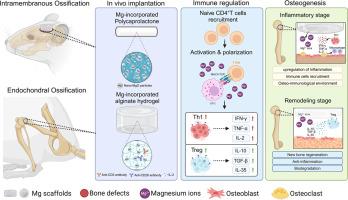具有免疫调节和成骨双重作用的含镁复合水凝胶支架通过调节CD4+ T细胞促进骨缺损修复
IF 13.8
1区 材料科学
Q1 METALLURGY & METALLURGICAL ENGINEERING
引用次数: 0
摘要
骨缺损修复的临床挑战推动了具有免疫调节和成骨功能的新型生物材料的探索。虽然以前的研究主要集中在骨免疫微环境中的巨噬细胞,但对T细胞,特别是“导体”CD4+ T细胞的调节机制仍然知之甚少。本研究利用Mg2+功能化复合材料研究了镁离子(Mg2+)对CD4+ T细胞极化及其介导的骨再生的影响。结果表明,适宜的Mg2+浓度范围可显著增强CD4+ T细胞的活化和增殖,促进Th1和Treg亚型的极化,从而建立促炎和抗炎协同的免疫微环境。条件培养基实验进一步证实,CD4+ T细胞分泌的细胞因子与Mg2+协同增强骨髓间充质干细胞(MSCs)碱性磷酸酶活性和钙沉积,同时减轻高浓度Mg2+对成骨的抑制作用。然后,设计纳米氧化镁掺杂聚己内酯支架(Mg-PCL)和T细胞激活剂交联海藻酸镁水凝胶(T- mg - gel)来控制Mg2+的释放。体内评估显示,1%Mg-PCL支架通过持续释放Mg2+促进颅骨缺损的膜性骨化,而T-Mg-Gel通过抑制早期炎症和促进长期Treg细胞调节来加速骨再生。本研究揭示了CD4+ T细胞在骨免疫学中的关键作用,为设计具有免疫调节和成骨双重功能的智能骨修复材料提供了一种新的策略。本文章由计算机程序翻译,如有差异,请以英文原文为准。

Magnesium-containing composite hydrogel scaffolds with immunomodulatory and osteogenic dual effects enhance bone defect repair via CD4+ T cells modulation
The clinical challenges of bone defect repair have driven the exploration of novel biomaterials with immunomodulatory and osteogenic functionalities. While previous studies predominantly focused on macrophages in the osteoimmune microenvironment, the regulatory mechanisms of T cells, particularly "conductor" CD4+ T cells, remain poorly understood. This study investigated the effects of magnesium ions (Mg2+) on CD4+ T cell polarization and their mediated bone regeneration using Mg2+-functionalized composite materials. Results demonstrated that suitable Mg2+ concentration range significantly enhanced CD4+ T cell activation and proliferation, promoting polarization toward Th1 and Treg subtypes, thereby establishing a pro-inflammatory and anti-inflammatory synergistic immune microenvironment. Conditioned medium experiments further confirmed that cytokines secreted from CD4+ T cells synergized with Mg2+ to augment alkaline phosphatase activity and calcium deposition in bone marrow mesenchymal stem cells (MSCs), while mitigating the inhibitory effects of high Mg2+ concentrations on osteogenesis. Then, nano-magnesium oxide-doped polycaprolactone scaffolds (Mg-PCL) and T cell activator-crosslinked magnesium-alginate hydrogels (T-Mg-Gel) were engineered to control the release of Mg2+. In vivo evaluations revealed that 1%Mg-PCL scaffolds facilitated membranous ossification in cranial defects via sustained Mg2+ release, whereas T-Mg-Gel accelerated bone regeneration by suppressing early-stage inflammation and promoting long-term Treg cell regulation. This study revealed the pivotal role of CD4+ T cells in osteoimmunology and provides a novel strategy for designing intelligent bone repair materials with dual immunomodulatory and osteogenic capabilities.
求助全文
通过发布文献求助,成功后即可免费获取论文全文。
去求助
来源期刊

Journal of Magnesium and Alloys
Engineering-Mechanics of Materials
CiteScore
20.20
自引率
14.80%
发文量
52
审稿时长
59 days
期刊介绍:
The Journal of Magnesium and Alloys serves as a global platform for both theoretical and experimental studies in magnesium science and engineering. It welcomes submissions investigating various scientific and engineering factors impacting the metallurgy, processing, microstructure, properties, and applications of magnesium and alloys. The journal covers all aspects of magnesium and alloy research, including raw materials, alloy casting, extrusion and deformation, corrosion and surface treatment, joining and machining, simulation and modeling, microstructure evolution and mechanical properties, new alloy development, magnesium-based composites, bio-materials and energy materials, applications, and recycling.
 求助内容:
求助内容: 应助结果提醒方式:
应助结果提醒方式:


